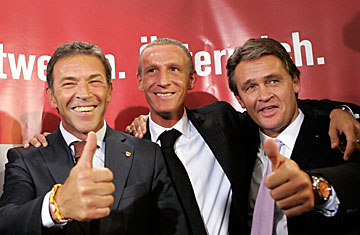
Jörg Haider, left, the top candidate of the Alliance for the Future of Austria, poses with a campaign official and candidate Peter Westenthaler in Vienna.
Most Austrian awoke with a shock on Monday when they learned that two anti-immigrant, anti-E.U. parties together won an unprecedented 29% of the vote in Sept. 28 elections, bringing the far right almost even with the mainstream Social Democratic Party in the Austrian Parliament. The Freedom Party and the breakaway Alliance for the Future of Austria — led by former Freedom Party leader Jörg Haider — managed to double the far right's share of the vote in the two years since the last elections.
"This is like a dream for us," the perpetually tanned Haider told reporters in Klagenfurt, where he serves as governor of the province of Carinthia. In 1999, he led the Freedom Party to 27% of the vote, and when he was invited into government, the European Union imposed controversial sanctions on Vienna.
Sunday's result renewed fears in Europe that Hitler's native land was seeing a resurgence of neo-Nazism. But the success of the two far-right parties is not a reprise of the 1930s; it is the consequence, say commentators, of more recent developments. There is massive disenchantment with the country's mainstream Social Democratic Party and conservative People's Party, which have shared power in a "grand coalition" in Austria for all but 18 of the 63 years since the end of the Second World War. Their latest coalition government lasted just 18 months and was widely considered a catastrophe for failing to produce a single major legislative initiative. The result also underscores growing unhappiness with an expanded European Union in a Central European country that has always felt vulnerable to migrant flows from the east. Immigration is controversial across Europe, but Austria's far right has been particularly skillful at focusing public anger on its alleged risks.
"It's astonishing to see how the mainstream parties have resurrected the right wing in Austria," says Thomas Hofer, a political analyst and former editor at the newsmagazine Profil. "Just three years ago the right wing was nowhere. But the last government gave them new life. This was the largest and most dramatic protest vote [since the Second World War]."
Kleine Zeitung columnist Hubert Patterer called the election an "outpouring of fury against the political class." In an unsigned editorial, the Vienna daily Die Presse argued against a simplistic reading of the result. "To conclude that close to 30% of all Austrians have suddenly ideologically moved to the right is certainly a false assumption," writes. "The reasons for the comet-like rise of the right lies, rather, in the behavior of the long-established people's parties. And this indeed poses a threat for the freedom of opinion and ideas in Austria."
A final tally in the vote is not expected until October 6. But according to the latest results, the Social Democrats won 29% of the total and the conservative People's Party 26%, down 5.5 and 9 points, respectively, from two years ago. One senior People's Party official lamented the outcome as the worst in his party's history.
The Freedom Party, meanwhile, saw its support jump by more than half to 18%, and was the outright winner among young Austrians under the age of 30. Haider, who broke with the Freedom Party to form his own Alliance for the Future of Austria in 2005, doubled his support in the few weeks immediately preceding the polls to garner an unexpected 11%. Within the 183-seat parliament, the Freedom Party is projected to take 35 seats, up from 21, while Haider's party is expected to get 21, up from just 7.
In the absence of a clear winner, coalition talks to form a government are expected to drag on for months. Both big mainstream parties have vowed that they will not form a coalition with the far right, but given the strength of those parties' showing, and the weakness of Austria's other small parties, including the Greens, commentators are not ruling anything out. For his part, Haider said after the vote that the two far-right parties should consider papering over their differences and joining forces. "Voters now expect us to do something for Austria," he said. "They do not want us steeped in animosity and fighting each other." During the campaign Haider, 58, eschewed his formerly harsh anti-immigrant rhetoric as a way of distinguishing himself from Freedom Party leader Heinz-Christian Strache, 39, a dental technician who broke with Haider three years ago.
The growing clout of the two parties raises questions about the future direction of Austrian policy. Already the country has turned sharply against an E.U. constitution; even the Social Democrats have said that no new document would be approved without a popular referendum, which would almost certainly fail. The number of immigrants entering Austria is small compared to that of Spain and some other E.U. countries. But Strache nevertheless got traction with his calls for curbs on "criminal immigrants," including implanting electronic chips in anyone convicted of a crime to allow the authorities to monitor their movements.
The dilemma confronting opponents of Austria's far right is that the parties appear to thrive in opposition. The last time that the Freedom Party was included in a governing coalition, its support crumbled. Over the past two years in pure opposition, by contrast, they have ridden from success to success. Strache has said he would like to be Chancellor some day. Unless Austria's mainstream parties can find a way to share power and work together in a more effective and responsive way, he may eventually get his wish.
